- Joined
- Feb 2, 2011
- Messages
- 2,093
NEW RELEASES FOR OCTOBER 2024
THE CONQUEST OF AMERICA
THE INCA EMPIRE
The Inca Empire was the largest empire in pre-Columbian America.
The Inca civilization rose from the Peruvian highlands sometime in the early 13th Century. The administrative, political and military centre of the empire was in the city of Cusco.
From 1438 to 15 33 the Incas incorporated a large portion of western South America, centered on the Andean Mountains, using conquest and peaceful assimilation, among other methods.
At its largest, the Empire joined modern day Peru, what is now western Equador, western and South central Bolivia, northwest Argentina, the southwest tip of Columbia and a large portion of modern day Chile, into a state comparable to the historical empires of Eurasia.
Its official language was Quechua.
The Spanish began the conquest of the Inca Empire in 1532 and by 1572 the last Inca state was fully conquered.
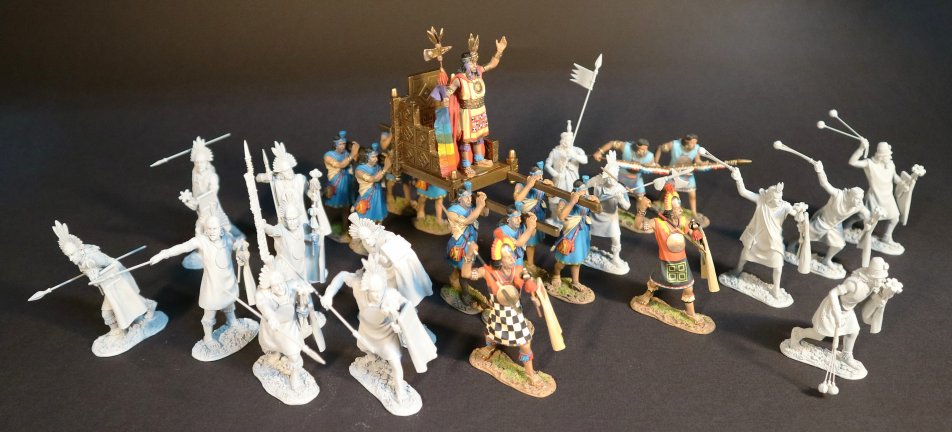
The Inca Empire was unique in that it lacked many of the features associated with civilization in the old world. The Incas were able to construct one of the greatest imperial states in human history without the use of the wheel, draft animals, knowledge of iron or steel, or even a system of writing.
They were also capable of monumental architecture, especially the use of stonework, extensive road networks reaching all corners of the empire, finely woven textiles, use of knotted strings for record keeping and communication, agricultural innovations and production in a difficult environment, and the organization and management fostered or imposed on its people and their labour.
The Inca Empire functioned largely without money and without markets. Instead, exchange of goods and services was based on reciprocity between individuals and among individuals, groups, and Inca rulers.
Taxes consisted of a labour obligation of a person to the Empire. The Inca rulers reciprocated by granting access to land and goods and providing food and drink in celebratory feasts for their subjects.
The Sapa Inca was the monarch of the Inca Empire, as well as ruler of the earlier kingdom of Cusco.
Whilst the origins of the position are mythical and originate from the legendary foundation of the city of Cusco, it seems to have come into being historically around 1100AD.
Although the Inca believed the Sapa to be the son of Inti (the Inca sun god) the position eventually became hereditary, with son succeeding father.
The Sapa Inca was at the top of the social hierarchy, and played a dominant role in the political and spiritual realm.
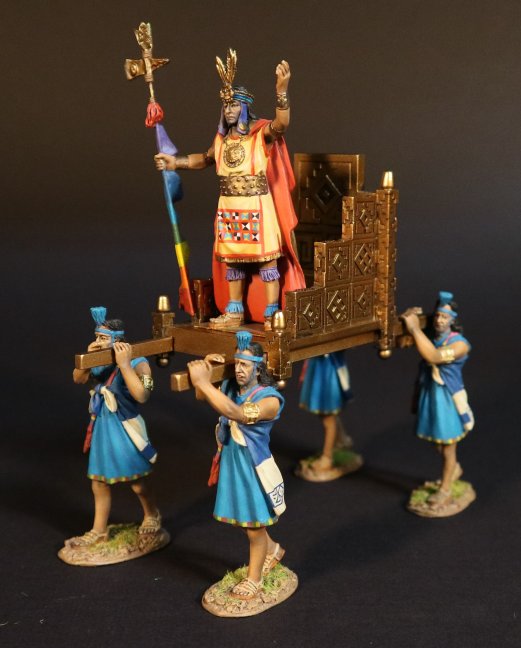
INCA-01
THE CONQUEST OF AMERICA,
THE INCA EMPIRE,
INCA LITTER
The Inca litter carried the commanding officers and the Sapa Inca.
Traditionally it was carried by men from Callahuaya for short trips, and for longer distances by Lucana tribesmen of the provinces of Lucana and Sora, and they were known as the “feet of the Inca”.
They were trained for this special role from the age of 20, and were usually uniformed in blue.
Pictorial sources invariably show the litter born by just four men, but it is believed that this is just an illustrative convention, since text references mention eight or sometimes even as many as 20 bearers.
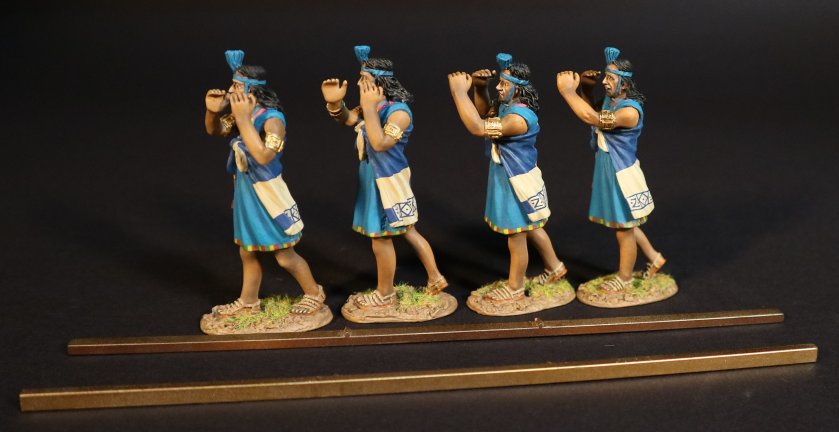
INCA-01A
THE CONQUEST OF AMERICA,
THE INCA EMPIRE,
INCA LITTER EXPANSION SET
The litter was normally accompanied by replacement crews, with it being recorded as a total of as many as 200-300 Lucanas accompanying the Sapa Inca’s litter.
Warriors from the Carabaya Tribe replaced the traditional Lucanas as the royal litter-bearers, after the Lucanas had deserted in the early stages of the Spanish conquest. They had defected to Pizarro’s side even before the conquistadores had entered Cuzco.
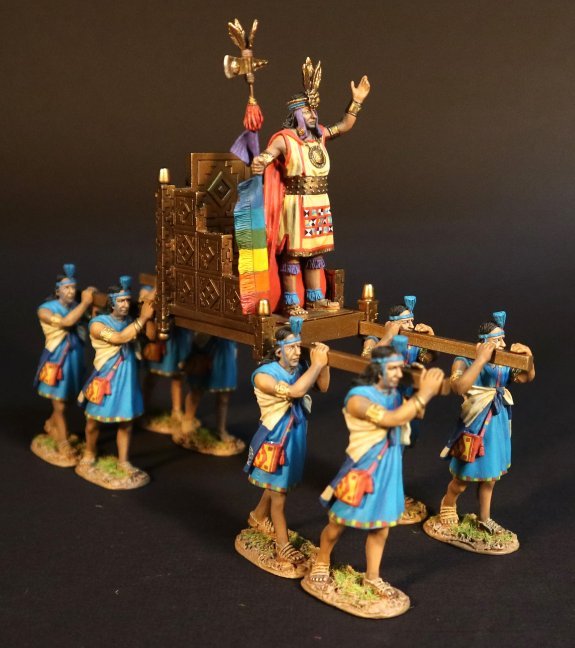
THE JAMESTOWN SETTLEMENT
THE ANGLO-POWHATAN WARS
Spain, Portugal, and France moved quickly to establish a presence in the New World. The English did not attempt to establish colonies until many decades after their explorations of John Cabot, with early efforts proving to be failiures, most notably the Roanoke Colony which vanished around 1590.
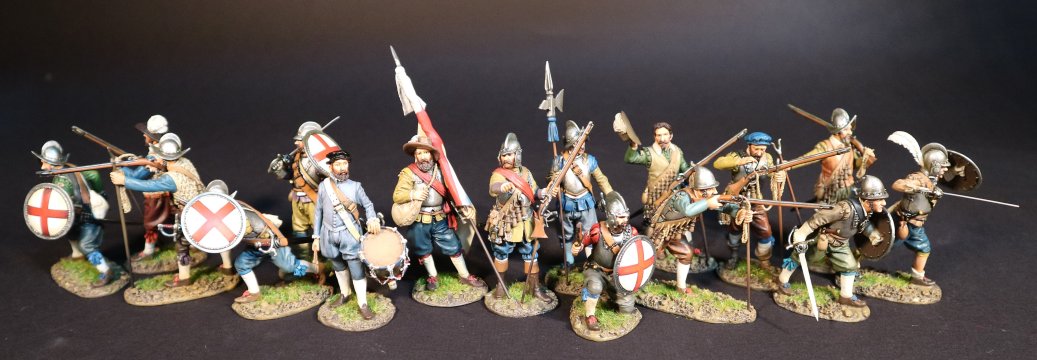
The Jamestown settlement in the colony of Virginia was the first permanent English settlement in the Americas. It was located on the northwest bank of the James (powhatan) river, about 2 ½ miles southwest of the centre of modern Williamsburg.
It was established by the Virginia Company of London, as James Fort on May 4th 1607.
The Anglo-Powhatan Wars were three conflicts fought between settlers of the Virginia Colony and Algonquin Indians of the Powhatan Confederacy in the early seventeenth Century.
The first war started in 1609 and ended in a peace settlement in 1614.
After several years of strained co-existence, Chief Opechancanough and his Powhatan Confederacy attempted to eliminate the English colony. This was the start of the second war which was to last from 1622 to 1626.
On the morning of March 22, 1622, the confederacy attacked outlying plantations and communities along the James River in what became known as the Indian Massacre of 1622.
More than 300 settlers were killed in the attack, which was about a third of the colony’s English speaking population.
Jamestown was spared only through a timely warning by a Virginia Indian employee.
Powhatan war practice was to wait and see what would happen after inflicting such a blow, in hopes that the settlement would simply abandon their homeland and move on elsewhere.
However, English military doctrine called for a strong response, and the colonial militia marched out nearly every summer for the next 10 years and made assaults on Powhatan settlements.
Opechancanough was to sue for peace in 1623.
The war lasted until Samuel Argall captured Wahunsenacawh’s daughter Matoaka, better known by her nickname Pocahontas, after which the chief accepted a treaty of peace.
The third war lasted from 1644 until 1646 and ended when Opechancanough was captured and killed. The war resulted in a defined boundary between the Indians and colonial lands that could only be crossed for official business with a special pass.
This situation lasted until 1677 and the Treaty of Middle Plantation which established Indian Reservations following Bacon’s Rebellion.
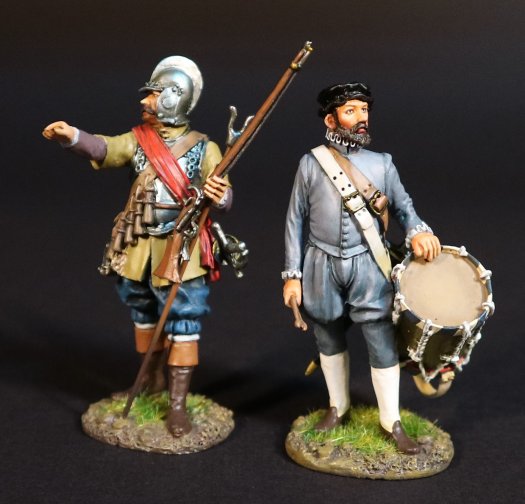
JT-01
THE CONQUEST OF AMERICA,
THE JAMESTOWN SETTLEMENT,
THE ANGLO-POWHATAN WARS
VIRGINIA MILITIA,
OFFICER AND DRUMMER
**PLEASE CONTACT YOUR LOCAL DEALER FOR FURTHER INFORMATION**
THE CONQUEST OF AMERICA
THE INCA EMPIRE
The Inca Empire was the largest empire in pre-Columbian America.
The Inca civilization rose from the Peruvian highlands sometime in the early 13th Century. The administrative, political and military centre of the empire was in the city of Cusco.
From 1438 to 15 33 the Incas incorporated a large portion of western South America, centered on the Andean Mountains, using conquest and peaceful assimilation, among other methods.
At its largest, the Empire joined modern day Peru, what is now western Equador, western and South central Bolivia, northwest Argentina, the southwest tip of Columbia and a large portion of modern day Chile, into a state comparable to the historical empires of Eurasia.
Its official language was Quechua.
The Spanish began the conquest of the Inca Empire in 1532 and by 1572 the last Inca state was fully conquered.

The Inca Empire was unique in that it lacked many of the features associated with civilization in the old world. The Incas were able to construct one of the greatest imperial states in human history without the use of the wheel, draft animals, knowledge of iron or steel, or even a system of writing.
They were also capable of monumental architecture, especially the use of stonework, extensive road networks reaching all corners of the empire, finely woven textiles, use of knotted strings for record keeping and communication, agricultural innovations and production in a difficult environment, and the organization and management fostered or imposed on its people and their labour.
The Inca Empire functioned largely without money and without markets. Instead, exchange of goods and services was based on reciprocity between individuals and among individuals, groups, and Inca rulers.
Taxes consisted of a labour obligation of a person to the Empire. The Inca rulers reciprocated by granting access to land and goods and providing food and drink in celebratory feasts for their subjects.
The Sapa Inca was the monarch of the Inca Empire, as well as ruler of the earlier kingdom of Cusco.
Whilst the origins of the position are mythical and originate from the legendary foundation of the city of Cusco, it seems to have come into being historically around 1100AD.
Although the Inca believed the Sapa to be the son of Inti (the Inca sun god) the position eventually became hereditary, with son succeeding father.
The Sapa Inca was at the top of the social hierarchy, and played a dominant role in the political and spiritual realm.

INCA-01
THE CONQUEST OF AMERICA,
THE INCA EMPIRE,
INCA LITTER
The Inca litter carried the commanding officers and the Sapa Inca.
Traditionally it was carried by men from Callahuaya for short trips, and for longer distances by Lucana tribesmen of the provinces of Lucana and Sora, and they were known as the “feet of the Inca”.
They were trained for this special role from the age of 20, and were usually uniformed in blue.
Pictorial sources invariably show the litter born by just four men, but it is believed that this is just an illustrative convention, since text references mention eight or sometimes even as many as 20 bearers.

INCA-01A
THE CONQUEST OF AMERICA,
THE INCA EMPIRE,
INCA LITTER EXPANSION SET
The litter was normally accompanied by replacement crews, with it being recorded as a total of as many as 200-300 Lucanas accompanying the Sapa Inca’s litter.
Warriors from the Carabaya Tribe replaced the traditional Lucanas as the royal litter-bearers, after the Lucanas had deserted in the early stages of the Spanish conquest. They had defected to Pizarro’s side even before the conquistadores had entered Cuzco.

THE JAMESTOWN SETTLEMENT
THE ANGLO-POWHATAN WARS
Spain, Portugal, and France moved quickly to establish a presence in the New World. The English did not attempt to establish colonies until many decades after their explorations of John Cabot, with early efforts proving to be failiures, most notably the Roanoke Colony which vanished around 1590.

The Jamestown settlement in the colony of Virginia was the first permanent English settlement in the Americas. It was located on the northwest bank of the James (powhatan) river, about 2 ½ miles southwest of the centre of modern Williamsburg.
It was established by the Virginia Company of London, as James Fort on May 4th 1607.
The Anglo-Powhatan Wars were three conflicts fought between settlers of the Virginia Colony and Algonquin Indians of the Powhatan Confederacy in the early seventeenth Century.
The first war started in 1609 and ended in a peace settlement in 1614.
After several years of strained co-existence, Chief Opechancanough and his Powhatan Confederacy attempted to eliminate the English colony. This was the start of the second war which was to last from 1622 to 1626.
On the morning of March 22, 1622, the confederacy attacked outlying plantations and communities along the James River in what became known as the Indian Massacre of 1622.
More than 300 settlers were killed in the attack, which was about a third of the colony’s English speaking population.
Jamestown was spared only through a timely warning by a Virginia Indian employee.
Powhatan war practice was to wait and see what would happen after inflicting such a blow, in hopes that the settlement would simply abandon their homeland and move on elsewhere.
However, English military doctrine called for a strong response, and the colonial militia marched out nearly every summer for the next 10 years and made assaults on Powhatan settlements.
Opechancanough was to sue for peace in 1623.
The war lasted until Samuel Argall captured Wahunsenacawh’s daughter Matoaka, better known by her nickname Pocahontas, after which the chief accepted a treaty of peace.
The third war lasted from 1644 until 1646 and ended when Opechancanough was captured and killed. The war resulted in a defined boundary between the Indians and colonial lands that could only be crossed for official business with a special pass.
This situation lasted until 1677 and the Treaty of Middle Plantation which established Indian Reservations following Bacon’s Rebellion.

JT-01
THE CONQUEST OF AMERICA,
THE JAMESTOWN SETTLEMENT,
THE ANGLO-POWHATAN WARS
VIRGINIA MILITIA,
OFFICER AND DRUMMER
**PLEASE CONTACT YOUR LOCAL DEALER FOR FURTHER INFORMATION**

